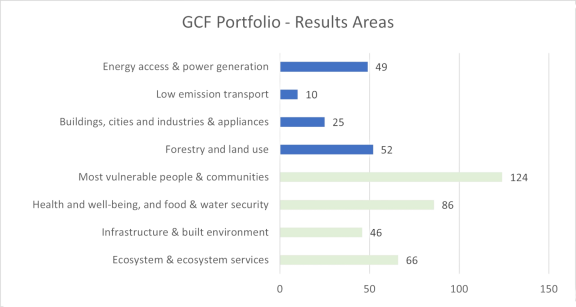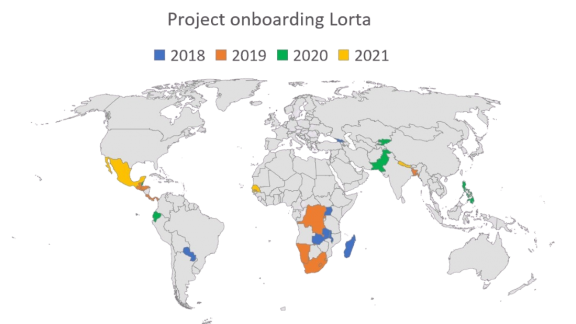B.34 Data Outlook: Funding proposals for Board’s consideration
On 8 September 2022, I was in a small village outside of London when I heard the news about the Queen’s passing. I tried to remember when exactly I last visited the UK, but I could not. Too many things have happened since then, and a lot has changed. But of course, the degree of change I felt in this visit was nothing compared to what Queen Elizabeth II must have witnessed in the span of her reign – the sweeping changes that the UK and other Commonwealth countries saw and experienced in the last 70 years. My deepest condolences to the Royal family.
The purpose of my visit this time around was to participate in a conference to discuss transformational change. Based on the definition used by the conference, transformational change is “fundamental change of the social, economic and environmental systems to ensure that they are no longer exploitative, but will enter into a dynamic, adaptive and resilient balance within planetary boundaries and limits, to ensure a sustainable future.” At the Green Climate Fund (GCF), we support developing countries to achieve a paradigm shift toward low-carbon and climate-resilient development pathways through various financial instruments.
Newly proposed funding proposals (FPs) for GCF’s 34th Board Meeting
From 17 to 20 October 2022, the 34th meeting of the GCF Board (B.34) will take place in Incheon, Republic of Korea. During B.34, nine funding proposals (FPs) will be presented for the Board’s approval. In this blog, I would like to present a brief overview of the new FPs that will be presented at this Board meeting. Additionally, I will present information about the GCF projects that are part of IEU’s Learning-Oriented Real-time Impact Assessment (LORTA) programme. The nine proposals to be discussed at B.34 encompass six public sector- and three private sector projects, including one proposal through the GCF’s Simplified Approval Process (SAP) modality.
Table 1. Funding proposals at B.34
| Funding proposal | Project title | Accredited entity | Thematic area | Country | GCF funding (in USD million) |
|---|---|---|---|---|---|
| FP191 | Enhancing Adaptation and Community Resilience by Improving Water Security in Vanuatu | SPC | Adaptation | Vanuatu | 23.3 |
| FP192 | The R's (Reduce, Reuse and Recycle) for Climate Resilience Wastewater Systems in Barbados (3RCReWS) | CCCCC | Cross-cutting | Barbados | 39.4 |
| FP193 | Peruvian Amazon Eco Bio Business Facility (Amazon EBBF) | Profonanpe | Mitigation | Peru | 9.0 |
| FP194 | Programme for Energy Efficiency in Buildings (PEEB) Cool | AFD | Cross-cutting | Albania, Argentina, Costa Rica, Djibouti, Indonesia, Mexico, Morocco, Nigeria, North Macedonia, Sri Lanka, Tunisia | 220.5 |
| FP195 | E-Motion: E-Mobility and Low Carbon Transportation | CAF | Mitigation | Panama, Paraguay, Uruguay | 76.6 |
| FP196 | Supporting Innovative Mechanisms for Industrial Energy Efficiency Financing in Indonesia with Lessons for Replication in other ASEAN Member States | KDB | Mitigation | Indonesia | 105.0 |
| FP197 | Green Guarantee Company ("GGC") | MUFG Bank | Cross-cutting | Brazil, Gabon, India, Indonesia, Lao PDR, Philippines, Trinidad and Tobago | 82.5 |
| FP198 | CATALI.5°T Initiative: Concerted Action To Accelerate Local I.5° Technologies – Latin America and West Africa | GIZ | Mitigation | Argentina, Benin, Burkina Faso, Costa Rica, Cote d'Ivoire, Dominican Republic, Guinea, Honduras, Mauritania, Mexico, Niger, Senegal, Togo | 26.9 |
| SAP025 | Adaptation of agricultural production systems in Coastal Areas of Northwest Guinea-Bissau | OSS | Adaptation | Guinea-Bissau | 9.8 |
If all nine FPs are approved at B.34, it will add USD 593.1 million to the GCF portfolio of USD 10.75 billion. Further, this amount will leverage an additional USD 1.77 billion through co-finance.
Six of the submitted FPs for B.34 are public-sector proposals, requesting GCF funding of USD 378.6 million (64 per cent), and the remaining three FPs are private-sector proposals, requesting USD 214.4 million (36 per cent). For the FPs’ thematic focus, USD 363.6 million (61 per cent) is allocated for mitigation projects and USD 229.4 million (39 per cent) for adaptation projects. USD 329.9 million (56 per cent) is for international access entities, and USD 263.1 million (44 per cent) is for direct access entities. In terms of distribution among vulnerable countries, 6 FPs either partially or entirely target the least developed countries (LDCs), small island developing States (SIDS), and/or the African States, totaling USD 251.4 million (or 42 per cent of the total requested amount). It is expected that the six mitigation projects will result in the reduction of 89.6 million tons of carbon dioxide equivalent emissions. And the three adaptation projects are expected to reach 38.6 million beneficiaries, both direct and indirect.
And when it comes to assessing the results and impact of GCF investments, LORTA can provide the relevant capacity building and technical support around impact evaluation.
A snapshot of the LORTA programme
As a member of the LORTA team at the IEU, I would like to give you a quick tour of the programme. LORTA aims to enable projects to generate evidence on the climate projects funded by GCF and strengthen the capacity of project implementing partners in assessing the impact of GCF investments. Since 2018, the programme has onboarded 23 GCF projects, which corresponds to roughly 10 per cent of all approved GCF projects.[1] Figure 1 below shows when these projects were onboarded into the LORTA programme and where these projects are located. Currently, we have a balanced distribution of projects across Africa (8 projects), Asia-Pacific (6 projects), and Latin America and the Caribbean (7 projects).
Figure 1. LORTA projects by the year of onboarding and country
The overall GCF portfolio includes mitigation (56 projects), adaptation (81 projects) and cross-cutting (50 projects). Figure 3 shows that half of all projects in the LORTA portfolio fall under the theme of adaptation, followed by cross-cutting (7 projects) and mitigation (4 projects). Thus, there is room for the LORTA team to consider more mitigation projects going forward.
Source: Created by the author for the analysis
Now I would like to look at the eight results areas[1], defined through the GCF’s Integrated Results Management Framework (IRMF). In order to help refine the funding proposal, in particular with regards to the selection of impact and outcome indicators and the development of the project’s logframe, project teams are asked to identify results areas in the FP template. Each project needs to select at least one GCF result area it covers. A project can fall under multiple results areas from the adaptation and mitigation themes. Figure 5 shows the current distribution of projects under the LORTA window across the eight GCF results areas, whereas Figure 4 shows that of the overall GCF portfolio of projects. The two Figures demonstrate that there is a great similarity between the LORTA and overall portfolio of the GCF, in terms of results areas coverage.
Figure 4. Distribution of GCF portfolio across the eight GCF results areas
Source: Created by the author for the analysis
Figure 5. Distribution of LORTA portfolio across the eight results areas
Most of LORTA’s impact evaluations are still ongoing and depend on the progress made by the individual underlying project in implementation. Thus far, the project team, AE and IEU have published one fully completed impact evaluation report ‘Scaling up the Use of Modernized Climate Information and Early Warning Systems in Malawi’ on FP002.
Generally speaking, empirical evidence on the impacts of complex climate-related projects is rather scarce. For this, the IEU has produced several evidence gap maps to identify where the gaps are. Against this backdrop of insufficient empirical evidence on the impact of climate projects, it is important to generate more evidence, and LORTA can contribute to this work. The objective of LORTA is to enhance and strengthen the learning and accountability functions of the GCF accredited entities and implementing partners by supporting the real time needs and providing feedback to enable adaptive management of projects. To do this effectively, LORTA works and collaborates with a variety of stakeholders on the ground, including other UN agencies, MDBs, academia, and hopes to expand its network of partners further.
Please stay tuned for more updates from LORTA, including information about the GCF projects that will be newly onboarded into the LORTA portfolio in the future.
[1] Eight results areas originate from the GCF mitigation and adaptation logic models of the initial results management framework. These are: (for mitigation) energy access and power generation, low emission transport, buildings, cities and industries and appliances, forestry and land use; (for adaptation) most vulnerable people and communities, health and well-being, and food and water security, infrastructure and built environment, and ecosystem and ecosystem services.
[1] Prior to B.34, there are 200 approved GCF projects. For this analysis, I excluded 13 multi-regional projects.
Disclaimer: This guest blog was originally published by the author. The views expressed in this guest blog are the author's own and do not necessarily reflect the views of the Independent Evaluation Unit of the Green Climate Fund.



